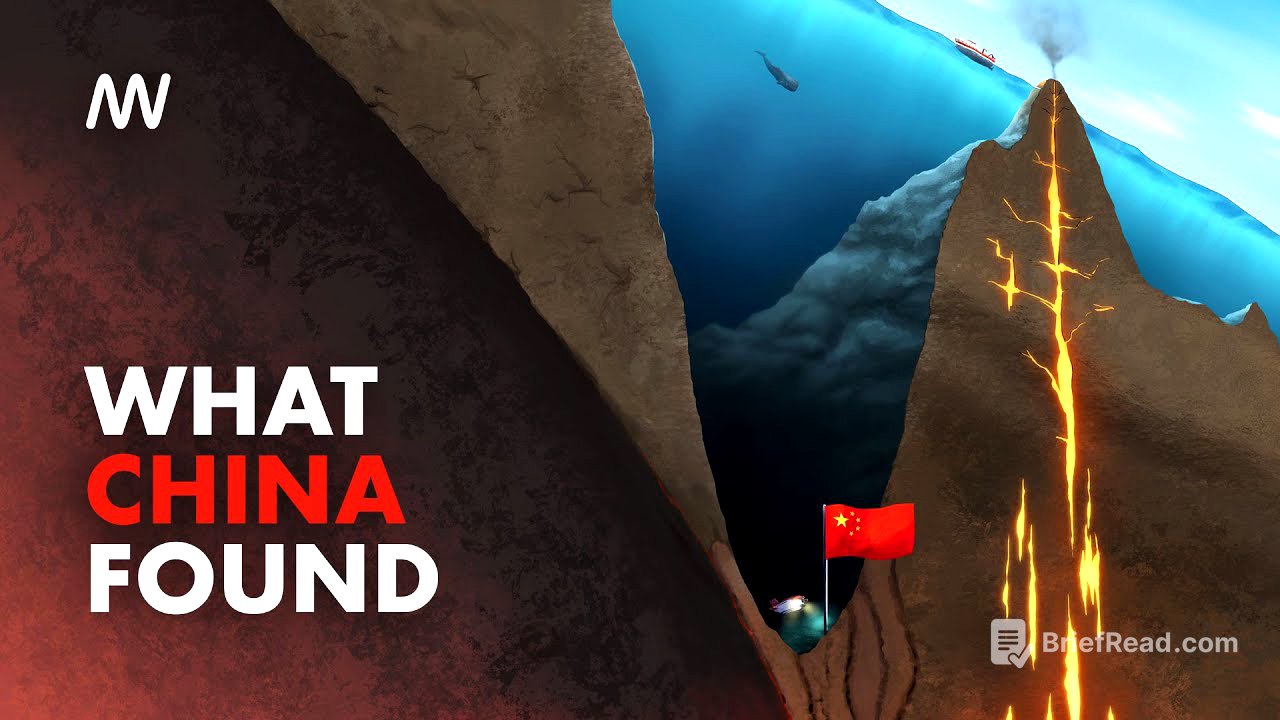TLDR;
This video explores the depths of the ocean, focusing on the Mariana Trench and China's increasing interest and investment in deep-sea exploration. It highlights the unique ecosystems, potential resources like methane hydrate and polymetallic nodules, and the strategic implications of controlling access to the deep sea. The video also touches on the risks of deep-sea mining, the vulnerability of undersea cables, and the growing technological competition between nations, particularly China and the US, in the race to understand and utilise the ocean's depths.
- The Mariana Trench is the deepest part of the ocean, with extreme pressure and unique life forms.
- China is heavily investing in deep-sea exploration with robots and underwater bases.
- The deep sea contains valuable resources like methane hydrate and polymetallic nodules.
- Deep-sea mining poses environmental risks.
- Undersea cables are vital for global communication and are vulnerable to damage.
- China is leading the ocean technology race, while the US is cutting back on funding.
Intro [0:00]
The video introduces the Mariana Trench, the deepest place on Earth, and highlights China's growing efforts to explore these depths. It suggests that China's interest extends beyond scientific research, hinting at a strategic move to claim resources and establish dominance in the deep sea. The video contrasts China's increasing investment with the US's reduction in ocean research programmes.
Photic Zone [1:17]
The journey to the bottom of the ocean begins at the surface, in the photic zone, which extends down to about 200 metres. This zone is characterised by warmth, sunlight, and abundant marine life, including coral reefs and various fish species. It's the part of the ocean most familiar to humans, where activities like swimming and snorkelling take place.
Twilight Zone: Fading Light Below [2:20]
As one descends deeper, one enters the twilight zone, or mesopelagic zone, which spans from 200 to 1,000 metres below the surface. Sunlight diminishes significantly, and the pressure increases to ten times that at sea level. This zone is home to unique creatures like the oarfish and sea angel, which have adapted to the increasing pressure and decreasing light. Animals in this zone often exhibit strange adaptations such as loss of colour and oversized eyes.
Midnight Zone: Total Darkness [3:29]
At 1,000 metres, one reaches the midnight zone, where there is total darkness. The only light is bioluminescence produced by the creatures themselves. Animals in this zone, such as the magnapa squid, have evolved bizarre features like glowing lures and transparent bodies. The pressure here is 100 times that at sea level, and the blobfish, in its natural habitat, is perfectly adapted to this intense pressure.
Abyssal Zone: Deceiving Mud [5:07]
Descending to 4,000 metres, one enters the abyssal zone, a cold, dark, and quiet environment. The seafloor appears as plain mud, but this mud is composed of marine snow, the remains of dead organisms that have sunk over millions of years. This layer of carbon-rich mud can be over a kilometre thick and acts as a significant carbon sink.
Marine Snow [5:50]
Marine snow is the continuous shower of organic material falling from the upper layers of the ocean to the deep sea. It consists of dead organisms, waste matter, and other particles. Over millions of years, this marine snow accumulates on the seafloor, forming thick layers of carbon-rich mud that preserve the ocean's history and trap carbon, making the deep sea a powerful natural carbon sink.
Whale Fall [7:05]
A whale fall occurs when a dead whale sinks to the sea floor, creating a temporary ecosystem. The whale's carcass attracts scavengers like sharks and hagfish, followed by worms, snails, and bacteria. A single whale can support life in this environment for years, providing a burst of energy in a food-scarce environment. The temperature is just above freezing, and the pressure is immense.
Hadal Zone: Into the Mariana Trench [8:41]
Below 6,000 metres lies the hadal zone, found exclusively in ocean trenches. Very few submarines can reach these depths due to the extreme pressure, which is more than 600 times that at the surface. Submersibles need a near-perfect pressure-proof design to survive.
Challenger Deep: Earth’s Deepest Point [11:02]
Challenger Deep is the deepest point in the Mariana Trench and the most extreme depth on Earth's sea floor, nearly 11,000 metres down. It was first reached in 1960, but only a few missions followed until China got involved. Despite the crushing pressure, life exists here, including giant single-celled organisms called xenophores and tiny shrimp.
China’s Deep Sea Drones [13:35]
China has moved beyond rare, one-off missions to a more ambitious and repeatable approach to deep-sea exploration. They are developing fleets of small, autonomous robots that can glide, crawl, or flex through the deep sea. These robots are designed for different tasks and work together to cover more ground at a fraction of the cost of traditional submarines.
Cold Seeps & Fire Ice: Hidden Ocean Energy [15:35]
Cold seeps are areas where methane and hydrogen sulphide seep up from beneath the sea floor, supporting unique ecosystems that thrive without sunlight. Methane hydrate, or fire ice, forms when methane gas is trapped inside a cage of ice under high pressure and cold temperatures. It is being studied as a potential fuel source, but extracting it is risky due to the potential for underwater landslides and the release of methane, a potent greenhouse gas.
Mining the Abyss: Riches vs. Ruin [17:39]
Polymetallic nodules, found scattered across the seabed, contain valuable metals like cobalt, nickel, copper, and manganese, essential for building batteries and renewable energy systems. These nodules are collected by robotic mining vehicles that crawl along the seabed, scooping up sediment and pumping it to the surface. This process creates sediment plumes that can smother fragile habitats and disrupt ecosystems, potentially causing irreversible damage.
China’s Underwater Base [20:36]
China is planning to build a permanent underwater base 2,000 metres below the surface, designed for scientists to live and work for extended periods. This base would provide China with valuable time to test new tools, monitor the environment, and gain experience operating in the deep sea, giving them a significant advantage in deep-sea exploration and resource control.
Seafloor Cables: The New Invisible War [22:04]
Deep-sea data cables, containing hair-thin glass fibres, carry most of the world's internet traffic and are surprisingly easy to damage. A ship dragging its anchor can knock a cable out, and there are concerns about sabotage and tampering. China has developed a deep-sea robot capable of cutting these cables, raising concerns about the potential to disrupt global communications and critical infrastructure.
The Deep Sea Talent Race [24:16]
China is heavily investing in ocean science, building research labs, funding programmes, and training the next generation of ocean engineers and scientists. They are also attracting top talent from around the world. In contrast, countries like the US are cutting science budgets, sidelining agencies responsible for ocean exploration and protection, leading to a loss of talent and research capabilities.
What China Discovered [25:48]
China has discovered not only life at the bottom of the ocean but also a way to access it and a reason to stay. They are transforming deep-sea exploration into a scalable strategy with autonomous robots and underwater research stations. They have uncovered resources that could power the next century and are developing the tools and experience to control access, positioning themselves to dictate what happens next in the deep sea.









